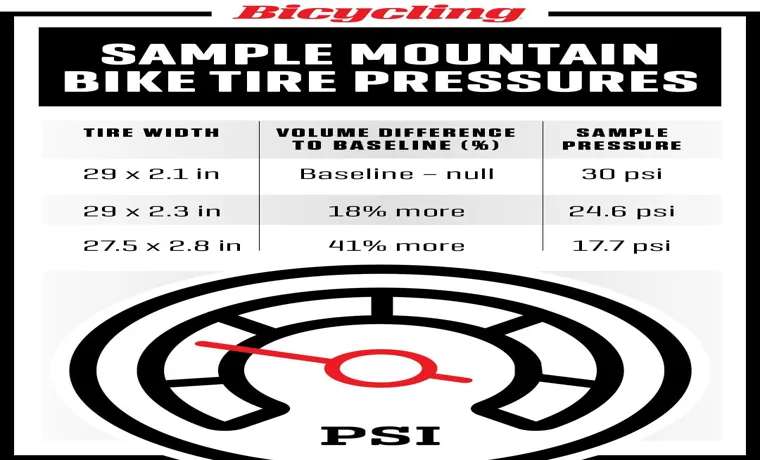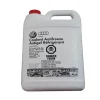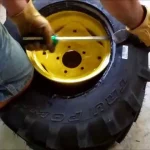A flat tire is perhaps one of the biggest road trip spoilers. That’s why having a spare tire tucked away in your car can be a godsend. However, do you know the proper tire pressure for your spare tire? If you don’t, you’re not alone.
Most people forget this little detail and when the time comes to use the spare tire, they’re hit with another problem. In this blog, we’ll discuss the importance of maintaining proper tire pressure for your spare tire, how to find the recommended pressure, and some tips to keep in mind. So, buckle up and let’s get started!
Table of Contents
Understanding PSI
If you ever find yourself with a flat tire and need to use your spare, your first question might be: how much psi does a spare tire need? The answer depends on your vehicle’s make and model, as well as the type of spare tire you have. Traditional full-size spares usually require the same psi as your regular tires (often around 30-35 psi), while donut spares typically require higher pressure (around 60 psi) because they aren’t intended for regular use. It’s always a good idea to check your owner’s manual to determine the recommended psi for your spare tire.
Keep in mind that driving on a spare tire for an extended period of time can be dangerous and decrease the lifespan of your other tires, so it’s important to get your regular tire repaired or replaced as soon as possible.
What is PSI
PSI, or pounds per square inch, is a unit of pressure commonly used in various settings. Whether you’re filling up a car tire, inflating a ball or checking water pressure, you’ll likely come across PSI measurements. Essentially, it measures the amount of force exerted by a gas or liquid on a surface per unit area.
To put it into perspective, think about a balloon filled with air. As you blow air into the balloon, you’re adding more pressure to the inside, making it expand and become tighter. The more air you add, the more pressure increases, until it eventually pops.
Similarly, in a car’s tire, a certain amount of pressure is needed to ensure it performs properly and doesn’t blow out. So next time you encounter PSI, you’ll know it’s all about measuring pressure.

Why is PSI Important
PSI (Pounds per Square Inch) is a crucial measurement used to determine the air pressure in tires, making it a critical factor in ensuring a safe and smooth ride. Proper tire pressure guarantees optimal vehicle handling, improved fuel efficiency, extended tire life, and enhanced safety. Understanding PSI is particularly crucial because both underinflated and overinflated tires can have negative effects on your car’s performance.
Overinflated tires are prone to punctures and blowouts, decreasing their contact patch with the road and leading to poor handling. On the other hand, when tires are underinflated, they have increased rolling resistance that causes significant wear and tear, overheating, and blowouts. Therefore, it is essential to keep your tires inflated to the manufacturer’s recommended PSI for your vehicle’s weight and tire size.
Regularly checking and adjusting your tire pressure is an easy and straightforward maintenance step that can significantly impact your driving experience. So, make sure you don’t overlook the significance of maintaining proper tire pressure and PSI!
How Much PSI is Needed for a Spare Tire
When it comes to spare tires, it’s important to know how much PSI they need to keep them operating safely. Typically, a spare tire will require about 60 PSI, but it’s crucial to check the owner’s manual to verify this information. Many people don’t give their spare tire a second thought until they experience a flat tire, leaving them stranded on the side of the road.
Ensuring that the spare tire has the proper amount of pressure is crucial to not only getting back on the road but keeping yourself and others safe while driving. Remember that a spare tire is only meant to be a temporary solution, so it’s essential to get the regular tire fixed or replaced as quickly as possible to prevent any accidents or further damage. So if you’re unsure about the PSI for your spare tire, be sure to check your owner’s manual or consult with a trusted mechanic to avoid any mishaps down the road.
Determining the Correct PSI
When it comes to determining the correct PSI for your spare tire, there are a few things to consider. First and foremost, you’ll want to check your vehicle’s owner’s manual to see what the manufacturer recommends. This is the best place to start and will give you a baseline to work with.
However, keep in mind that if you’ve replaced your spare tire with a different make or model, you may need to adjust the PSI accordingly. Another factor to consider is the weight that your tire will be carrying – if you plan to load up your vehicle heavily, you’ll want to increase the PSI to compensate. The key here is to strike a balance between having enough pressure in the tire to support the weight, while also avoiding over-inflating which can lead to a blowout.
With a little trial and error, you’ll be able to find the sweet spot that works for your specific situation.
Checking the Owner’s Manual
When it comes to using your spare tire, it’s important to know the correct air pressure to inflate it to. Most spare tires require a higher PSI than your regular tires, but the exact amount can vary depending on the make and model of your vehicle. That’s why it’s crucial to check the owner’s manual or the sticker on your door jamb for the correct tire pressure information.
Overinflating or underinflating your spare tire can have serious consequences – it can lead to decreased traction, poor handling, and even a blowout on the highway. To avoid these hazards and ensure your safety, take the time to check the recommended PSI for your spare tire and inflate it accordingly. Remember, a properly inflated spare tire can get you back on the road quickly and safely.
Using a Tire Pressure Gauge
When it comes to spare tires, it’s essential to ensure they’re properly inflated to avoid any tire-related mishaps on the road. The amount of PSI needed for a spare tire is typically lower than that of a regular tire, with the recommended pressure ranging between 30-35 PSI. However, it’s crucial to check your vehicle owner’s manual or the spare tire itself for the manufacturer’s specific recommendations.
Using a tire pressure gauge is the best way to ensure your spare tire is at the appropriate pressure level. Simply remove the valve cap, attach the gauge to the valve stem, and take a reading. If the pressure is too low, add air until you reach the recommended PSI.
Remember, a properly inflated spare tire can mean the difference between a minor inconvenience and a dangerous situation on the road.
Additional Tips for Handling Spare Tires
If you find yourself in a situation where you need to use a spare tire, it’s important that it’s properly inflated. The amount of PSI, or pounds per square inch, needed for a spare tire can vary depending on the vehicle. However, the general rule of thumb is to inflate the spare tire to the recommended PSI listed in the owner’s manual.
This is typically around 60 PSI for most vehicles. It’s important not to overinflate the tire, as this can cause it to burst. Additionally, it’s a good idea to regularly check the condition and pressure of your spare tire to ensure it’s in good shape when you need it.
Don’t wait until an emergency to discover that your spare tire is flat or in poor condition. Keep your spare tire properly inflated and in good condition to ensure your safety on the road.
Inspecting and Maintaining Spare Tires
When it comes to handling spare tires, there are some additional tips that can ensure their longevity and effectiveness. First and foremost, it’s important to check the spare tire’s pressure regularly, just like you would with your regular tires. This will help ensure that it’s ready to use in case of an emergency.
Secondly, it’s a good idea to inspect the spare tire for any signs of wear and tear, such as cracks or punctures. If you do notice any damage, it’s best to replace the tire with a new one. Additionally, storing your spare tire properly can also help it last longer.
Make sure to keep it out of direct sunlight and away from any sources of heat or moisture, as these can all cause damage to the tire. By following these simple tips, you can be sure that your spare tire is ready to go whenever you need it, saving you time and money in the long run.
Using a Temporary Spare Tire
If you ever find yourself in a situation where you have to use a temporary spare tire, there are a few things you need to keep in mind. Firstly, be aware that spare tires aren’t designed for long-term use and are not a replacement for your standard tires. They can help you get to the nearest repair shop, but you shouldn’t exceed the manufacturer’s recommended maximum speed and distance.
Also, spare tires have a lower weight tolerance than standard tires, so make sure to unload your trunk as much as you can to reduce the overall weight of your vehicle. In addition, temporary spare tires have a different handling characteristic than standard tires. Due to their smaller size and different construction, they can be less stable when cornering, braking, and accelerating.
So, you need to be extra cautious when driving with a spare tire. Keep your speed moderate, don’t make any sharp turns, and avoid any sudden movements. Lastly, as soon as you can, get your original tire fixed or replaced as soon as possible.
Don’t wait too long since spare tires aren’t meant for long-term use. Get back to your standard tires as soon as you can to ensure safe and optimal driving. By following these simple tips, you’ll be able to handle a temporary spare tire with ease and keep safe on the road.
Conclusion
In the world of spare tires, psi is the name of the game. Just like your morning cup of coffee, without the right amount of psi, your spare tire will leave you feeling flat and defeated. So, make sure to check the recommended psi for your spare tire and fill it up accordingly.
Because let’s face it, a flat spare tire is like a bad joke – no one wants to be stuck with it.”
FAQs
1. What is the recommended psi for a spare tire? A: The recommended psi for a spare tire is typically between 60-80 psi. 2. Can a spare tire be driven on for long distances? A: It is recommended to only use a spare tire as a temporary solution and to have it replaced with a new tire as soon as possible. 3. How do I know if my spare tire is properly inflated? A: You can use a tire pressure gauge to check the psi of your spare tire and ensure it matches the recommended pressure. 4. Is it necessary to replace a spare tire after it has been used? A: Generally, it is recommended to replace a spare tire after it has been used since it may have been subjected to wear and tear. 5. Can different types of spare tires have different psi requirements? A: Yes, depending on the type of spare tire (full-size, compact, or donut), the psi requirements may vary. 6. What happens if I overinflate my spare tire? A: Overinflating a spare tire can cause it to burst or become damaged, potentially leading to a dangerous situation while driving. 7. How often should I check the pressure of my spare tire? A: It is recommended to check the pressure of all tires, including the spare tire, at least once a month.




